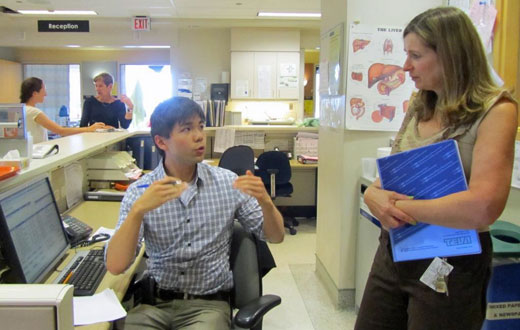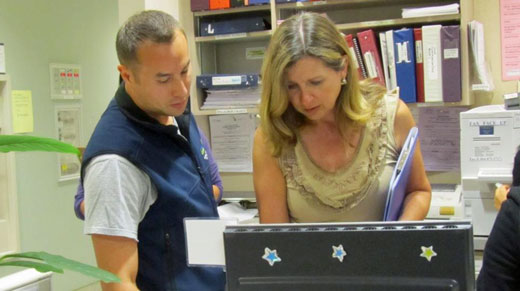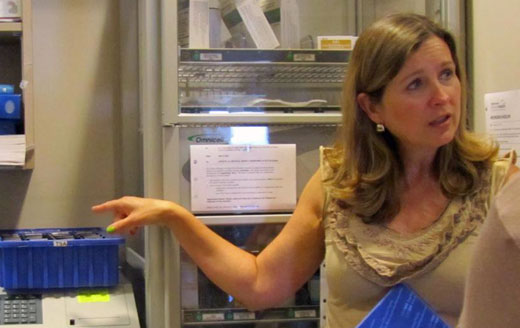
Pharmacist Jason Park explains to mock surveyor Janice Munroe how entering medication orders on the unit can cut medication delivery time in half.
“The purpose of this tracer is to see how the use of medications impacts patients and health care throughout the continuum of care,” explains Janice Munroe.
An Accreditation Canada (AC)surveyor, today she’s visiting UBCH and VGH as part of a mock tracer on Managing Medications, evaluating safe medication practices from the point of ordering, through to dispensing, and finally administration to the patient.
Janice’s role today is to help staff in our Pharmacy and clinical units prepare for the AC surveyors’ visit this November. When not doing surveys, Janice is a Regional Medication Safety Coordinator in Fraser Health.

At the Jim Pattison Pavilion, T9’s interim educator Peter Judson answers questions from mock surveyor Janice Munroe.
She speaks to several Pharmacy leaders about processes, how they respond to different situations, such as the recent medication shortage, and how they communicate to staff and patients about general medication use, such as disseminating information on new uses for existing drugs.
Moving on to VGH’s unit T9, a General Surgery unit, Janice asks RN Anna Ularte to show her how a patient’s medications are recorded and administered. Anna takes her through the relevant documentation and flow charts, demonstrating the steps that she follows to check all seven “rights”: medication, client (using two identifiers), dose, time, route, reason, and documentation.
When Janice comments that the documentation is different than that at UBCH, Amy Wai explains, “That’s because UBC is more sub-acute, while this unit is more acute.” Amy, an accreditation lead, is the interim pharmacy distribution coordinator for UBCH and GF Strong Rehabilitation Centre.
“That’s excellent,” Janice responds. She continues, examining how medications are stored, who has access to them, how we ensure that medications are stored securely, and any patient-identifying documents (i.e. the MAR) are stored in a way that protects patient confidentiality. Janice also checks the general conditions on the unit, including whether staff have access to a quiet space for transcribing medication orders without distractions. Her questions also spark discussions among the leaders shadowing her.
She stops to talk to pharmacist Jason Park, who is entering medication orders directly from the unit as part of a new trial. The process should shorten the turnaround for delivery of medication orders from two to three hours down to one. “It will help us solve problems faster,” Jason explains.
Janice makes a note of this new addition to what we do every day. Like accreditation, her evaluation will recognize what we do well, and offer suggestions for improvements so we can do it even better.
But – wait – there’s more!
Read more about accreditation and our quality improvement efforts in the September issue of Vancouver Accreditation 2012.

